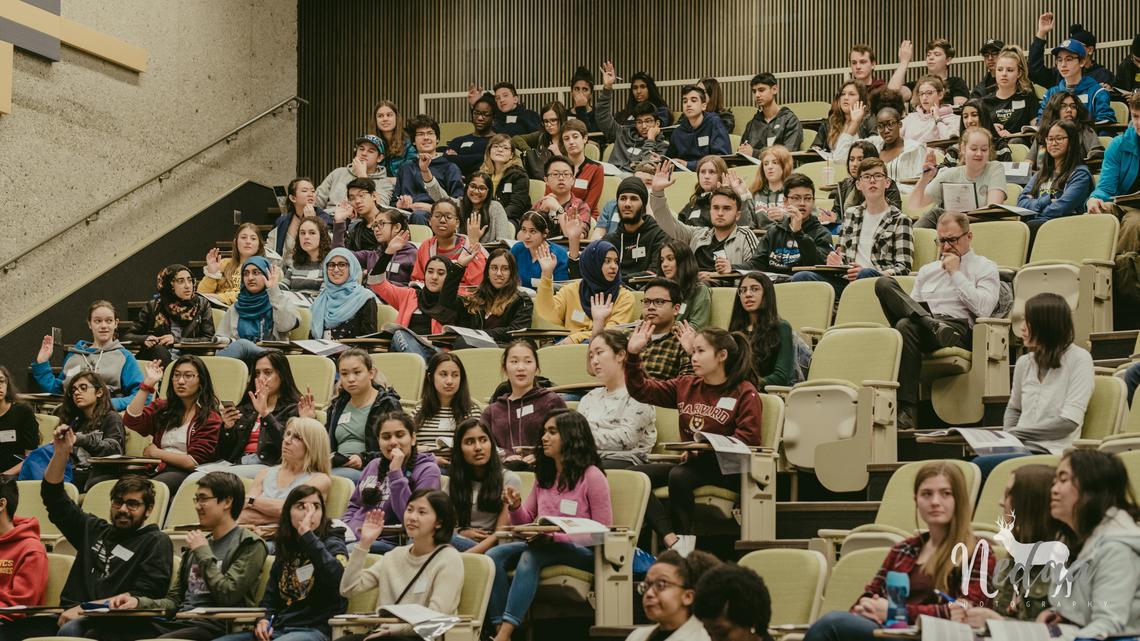May 24, 2019
Stem cell transplant recipient's journey inspires the next generation of scientists

Andrew Daly performed the stem cell transplant that cured Revée Agyepong's sickle cell anemia.
Nedaa Al-Jezani
Revée Agyepong knows first-hand the potential of stem cell research to change lives.
Born with sickle cell anemia, Agyepong was the first adult in Alberta to receive a stem cell transplant to cure the inherited disease. Sickle cell anemia causes red blood cells to become rigid and sickle-shaped. These misshapen cells can block blood vessels, leading to constant and severe pain, and a risk of stroke and organ damage.
Agyepong, who underwent hundreds of hospital visits from the age of two, says the disease made her life miserable. “It is a very deep, relentless intense pain, similar to someone taking a hammer to your bones.”
In front of an audience of some 180 students from high schools across Calgary, Agyepong talked about her painful journey towards a cure from her debilitating disease. In telling her story, she introduced students to the life-altering potential of stem cell research.
Agyepong agreed to the trial bone marrow transplant procedure knowing it could set an important precedent for how patients with sickle cell anemia are treated in the future. Her older sister was a 100-per-cent donor match for the transplant, providing the blood stem cells that went on to make her new red blood cells.
Dr. Andrew Daly, MD, who performed the transplant in 2017 at the Tom Baker Cancer Centre, says Agyepong’s family support and care were instrumental in her recovery.
“Revée is a remarkable person from a remarkable family,” says Daly, clinical associate professor, Departments of Medicine and Oncology, Cumming School of Medicine (CSM), and director of the Alberta Bone Marrow Transplant Program.
Although Agyepong was the first to receive such treatment in Alberta, the procedure is now becoming more common. Pediatric patients with sickle cell anemia are being offered transplants more frequently, as they tolerate the transplant procedure well and most have not developed irreversible problems from sickle cell. Daly says the use of stem cells for bone marrow transplants is just the beginning. “Understanding how to use our body’s stem cells to heal our tissues is amazing science,” he says. “There’s potential to use stem cells from cartilage and muscle to regenerate joints and heart muscle.” He advised students in the audience who are considering stem cell research to “do it now.”

The seventh-annual StemCellTalks event drew 180 high school students from across Calgary.
Inspiring the next generation of stem cell scientists
The event, hosted at UCalgary’s Foothills campus, is part of an outreach program in partnership with Let’s Talk Science to disseminate stem cell research to high school students in the Calgary area. Led by a dedicated team of graduate students keen to inspire younger students to consider a career in regenerative medicine and STEM disciplines broadly, the initiative provides a direct forum for students to engage with stem cell scientists and industry experts, discussing current scientific, medical, and ethical dilemmas surrounding the use of stem cells. This year’s topic was stem cells and the immune system.
"As graduate students, organizing StemCellTalks helps to inspire the next generation of stem cell scientists, much like how faculty at the University of Calgary inspired us," says Sarthak Sinha, a graduate student studying fibrotic disease with Dr. Jeff Biernaskie in the Faculty of Veterinary Medicine. "Stories like Revee's remind us of the impact our cumulative work can have on people's lives."
Other speakers at the day-long event included:
- Dr. Jeff Biernaskie, PhD, associate professor of stem cell biology in the Faculty of Veterinary Medicine, Calgary Firefighters Burn Treatment Society Chair in Skin Regeneration and Wound Healing, jointly appointed at CSM, and a member of the Alberta Children’s Hospital Research Institute and the Hotchkiss Brain Institute.
- Dr. Craig Jenne, PhD, assistant professor, Department of Microbiology, Immunology and Infectious Disease, Cumming School of Medicine.
- Dr. Ubaka Ogbogu, PhD, assistant professor, faculties of Law and Pharmacy and Pharmaceutical Sciences, University of Alberta.
